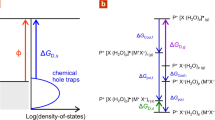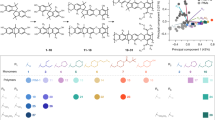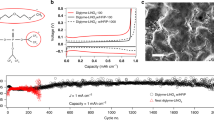Abstract
Recent advances in polymer synthesis have allowed remarkable control over chain microstructure and conformation. Capitalizing on such developments, here we create well-controlled chain folding in sulfonated polyethylene, leading to highly uniform hydrated acid layers of subnanometre thickness with high proton conductivity. The linear polyethylene contains sulfonic acid groups pendant to precisely every twenty-first carbon atom that induce tight chain folds to form the hydrated layers, while the methylene segments crystallize. The proton conductivity is on par with Nafion 117, the benchmark for fuel cell membranes. We demonstrate that well-controlled hairpin chain folding can be utilized for proton conductivity within a crystalline polymer structure, and we project that this structure could be adapted for ion transport. This layered polyethylene-based structure is an innovative and versatile design paradigm for functional polymer membranes, opening doors to efficient and selective transport of other ions and small molecules on appropriate selection of functional groups.
This is a preview of subscription content, access via your institution
Access options
Access Nature and 54 other Nature Portfolio journals
Get Nature+, our best-value online-access subscription
$29.99 / 30 days
cancel any time
Subscribe to this journal
Receive 12 print issues and online access
$259.00 per year
only $21.58 per issue
Buy this article
- Purchase on Springer Link
- Instant access to full article PDF
Prices may be subject to local taxes which are calculated during checkout




Similar content being viewed by others
References
Dobson, C. M. Protein folding and misfolding. Am. Sci. 90, 445–453 (2002).
Hill, D. J., Mio, M. J., Prince, R. B., Hughes, T. S. & Moore, J. S. A field guide to foldamers. Chem. Rev. 101, 3893–4011 (2001).
Ortmann, P. & Mecking, S. Long-spaced aliphatic polyesters. Macromolecules 46, 7213–7218 (2013).
Le Fevere de Ten Hove, C., Penelle, J., Ivanov, D. A. & Jonas, A. M. Encoding crystal microstructure and chain folding in the chemical structure of synthetic polymers. Nat. Mater. 3, 33–37 (2004).
Atallah, P., Wagener, K. B. & Schulz, M. D. ADMET: the future revealed. Macromolecules 46, 4735–4741 (2013).
Gaines, T. W., Trigg, E. B., Winey, K. I. & Wagener, K. B. High melting precision sulfone polyethylenes synthesized by ADMET chemistry. Macromol. Chem. Phys. 217, 2351–2359 (2016).
Caire da Silva, L., Rojas, G., Schulz, M. D. & Wagener, K. B. Acyclic diene metathesis polymerization: history, methods and applications. Prog. Polym. Sci. 69, 79–107 (2017).
Baughman, T., Chan, C., Winey, K. & Wagener, K. B. Synthesis and morphology of well-defined poly(ethylene-co-acrylic acid) copolymers. Macromolecules 40, 6564–6571 (2007).
Trigg, E. B., Stevens, M. J. & Winey, K. I. Chain folding produces a multilayered morphology in a precise polymer: simulations and experiments. J. Am. Chem. Soc. 139, 3747–3755 (2017).
Trigg, E. B., Middleton, L. R., Moed, D. E. & Winey, K. I. Transverse orientation of acid layers in the crystallites of a precise polymer. Macromolecules 50, 8988–8995 (2017).
Mandal, J., Krishna Prasad, S., Rao, D. S. S. & Ramakrishnan, S. Periodically clickable polyesters: study of intrachain self-segregation induced folding, crystallization, and mesophase formation. J. Am. Chem. Soc. 136, 2538–2545 (2014).
Gierke, T. D., Munn, G. E. & Wilson, F. C. The morphology in nafion perfluorinated membrane products, as determined by wide- and small- angle X-ray studies. J. Polym. Sci. Polym. Phys. Ed. 19, 1687–1704 (1981).
Eisenberg, A. Clustering of ions in organic polymers. A theoretical approach. Macromolecules 3, 147–154 (1970).
Diat, O. & Gebel, G. Fuel cells: proton channels. Nat. Mater. 7, 13–14 (2008).
Kreuer, K. D. & Portale, G. A critical revision of the nano-morphology of proton conducting ionomers and polyelectrolytes for fuel cell applications. Adv. Funct. Mater. 23, 5390–5397 (2013).
Mauritz, K. A. & Moore, R. B. State of Understanding of Nafion. Chem. Rev. 104, 4535–4585 (2004).
Kusoglu, A., Mosdestino, M. A., Hexemer, A., Segalman, R. A. & Weber, A. Z. Subsecond morphological changes in Nafion during water uptake detected by small-angle X-ray scattering. ACS Macro Lett. 1, 33–36 (2012).
Kreuer, K. D. Ion conducting membranes for fuel cells and other electrochemical devices. Chem. Mater. 26, 361–380 (2013).
Rubatat, L., Rollet, A. L., Gebel, G. & Diat, O. Evidence of elongated polymeric aggregates in Nafion. Macromolecules 35, 4050–4055 (2002).
Schmidt-rohr, K. & Chen, Q. Parallel cylindrical water nanochannels in Nafion fuel-cell membranes. Nat. Mater. 7, 75–83 (2008).
Li, N. & Guiver, M. D. Ion transport by nanochannels in ion-containing aromatic copolymers. Macromolecules 47, 2175–2198 (2014).
Vetter, S., Ruffmann, B., Buder, I. & Nunes, S. P. Proton conductive membranes of sulfonated poly(ether ketone ketone). J. Memb. Sci. 260, 181–186 (2005).
Fujimoto, C. H., Hickner, M. A., Cornelius, C. J. & Loy, D. A. Ionomeric poly(phenylene) prepared by Diels-Alder polymerization: synthesis and physical properties of a novel polyelectrolyte. Macromolecules 38, 5010–5016 (2005).
Elabd, Y. A. & Hickner, M. A. Block copolymers for fuel cells. Macromolecules 44, 1–11 (2011).
Elabd, Y. A., Napadensky, E., Walker, C. W. & Winey, K. I. Transport properties of sulfonated poly(styrene-b-isobutylene-b-styrene) triblock copolymers at high ion-exchange capacities. Macromolecules 39, 399–407 (2006).
Kim, H. K., Zhang, M., Yuan, X., Lvov, S. N. & Chung, T. C. M. Synthesis of polyethylene-based proton exchange membranes containing PE backbone and sulfonated poly(arylene ether sulfone) side chains for fuel cell applications. Macromolecules 45, 2460–2470 (2012).
Nakabayashi, K., Higashihara, T. & Ueda, M. Polymer electrolyte membranes based on cross-linked highly sulfonated multiblock copoly(ether sulfone)s. Macromolecules 43, 5756–5761 (2010).
Miyanishi, S., Fukushima, T. & Yamaguchi, T. Synthesis and property of semicrystalline anion exchange membrane with well-defined ion channel structure. Macromolecules 48, 2576–2584 (2015).
Gadjourova, Z., Andreev, Y. G., Tunstall, D. P. & Bruce, P. G. Ionic conductivity in crystalline polymer electrolytes. Nature 412, 520–523 (2001).
Cheng, S., Smith, D. M. & Li, C. Y. How does nanoscale crystalline structure affect ion transport in solid polymer electrolytes? Macromolecules 47, 3978–3986 (2014).
Schulz, M. D., Sauty, N. F. & Wagener, K. B. Morphology control in precision polyolefins. Appl. Petrochem. Res. 5, 3–8 (2015).
Buitrago, C. F. et al. Room temperature morphologies of precise acid- and ion-containing polyethylenes. Macromolecules 46, 9003–9012 (2013).
Middleton, L. R. et al. Hierarchical acrylic acid aggregate morphologies produce strain-hardening in precise polyethylene-based copolymers. Macromolecules 48, 3713–3724 (2015).
Seitz, M. E. et al. Nanoscale morphology in precisely sequenced poly(ethylene-co-acrylic acid) zinc ionomers. J. Am. Chem. Soc. 132, 8165–8174 (2010).
Gaines, T. W., Bell, M.H., Trigg, E. B., Winey, K. I. & Wagener, K. B. Precision sulfonic acid polyolefins via heterogenous to homogenous deprotection. Macromol. Chem. Phys. https://doi.org/10.1002/macp.201700634 (2018).
Kreuer, K. D., Paddison, S. J., Spohr, E. & Schuster, M. Transport in proton conductors for fuel cell applications: simulation, elementary reactions and phenomenology. Chem. Rev. 104, 4637–4678 (2004).
Feng, S. & Voth, G. A. Proton solvation and transport in hydrated Nafion. J. Phys. Chem. B 115, 5903–5912 (2011).
Choi, P., Jalani, N. H. & Datta, R. Thermodynamics and proton transport in Nafion. J. Electrochem. Soc. 152, E123–E130 (2005).
Suarez, S. N., Jayakody, J. R. P., Greenbaum, S. G., Zawodzinski, T. & Fontanella, J. J. A fundamental study of the transport properties of aqueous superacid solutions. J. Phys. Chem. B 114, 8941–8947 (2010).
Urata, S. et al. Molecular dynamics simulation of swollen membrane of perfluorinated ionomer. J. Phys. Chem. B 109, 4269–4278 (2005).
Lane, J. M. D., Chandross, M., Stevens, M. J. & Grest, G. S. Water in nanoconfinement between hydrophilic self-assembled monolayers. Langmuir 24, 5209–5212 (2008).
Leng, Y. & Cummings, P. T. Fluidity of hydration layers nanoconfined between mica surfaces. Phys. Rev. Lett. 94, 19–22 (2005).
Savage, J. & Voth, G. A. Persistent subdiffusive proton transport in perfluorosulfonic acid membranes. J. Phys. Chem. Lett. 5, 3037–3042 (2014).
Perrin, J., Lyonnard, S., Guillermo, A. & Levitz, P. Water dynamics in ionomer membranes by field-cycling NMR relaxometry. J. Phys. Chem. B 110, 5439–5444 (2006).
Jankowska, A., Zalewska, A., Skalska, A., Ostrowski, A. & Kowalak, S. Proton conductivity of imidazole entrapped in microporous molecular sieves. Chem. Commun. 53, 2475–2478 (2017).
Trigg, E. B., Tiegs, B. J., Coates, W. & Winey, K. I. High morphological order in a nearly precise acid-containing polymer and ionomer. ACS Macro Lett. 6, 947–951 (2017).
Zawodzinski, T. A. et al. Water uptake by and transport through Nafion 117 membranes. J. Electrochem. Soc. 140, 1041–1047 (1993).
Yin, Y. et al. Synthesis, proton conductivity and methanol permeability of a novel sulfonated polyimide from 3-(2′,4′-diaminophenoxy)propane sulfonic acid. Polymer 44, 4509–4518 (2003).
Abbott, L. J. & Frischknecht, A. L. Nanoscale structure and morphology of sulfonated polyphenylenes via atomistic simulations. Macromolecules 50, 1184–1192 (2017).
Gaines, T. W. Oxidized Sulfur Functionalized Polymers via ADMET Polymerization. PhD thesis, Univ. Florida (2015).
Gaines, T. W. & Wagener, K. B. Sulfonated polyethylene. US patent 9,724,686 (2017).
Salas-De La Cruz, D. et al. Environmental chamber for in situ dynamic control of temperature and relative humidity during X-ray scattering. Rev. Sci. Instrum. 83, 025112 (2012).
Heiney, P. Datasqueeze: a software tool for powder and small-angle X-ray diffraction analysis. Comm. Powder Diffr. Newsl. 32, 9–11 (2005).
Abràmoff, M. D., Magalhães, P. J. & Ram, S. J. Image processing with ImageJ. Biophoton. Int. 11, 36–41 (2004).
Plimpton, S. Fast parallel algorithms for short-range molecular dynamics. J. Comput. Phys. 117, 1–19 (1995).
Siu, S. W. I., Pluhackova, K. & Böckmann, R. A. Optimization of the OPLS-AA force field for long hydrocarbons. J. Chem. Theory Comput. 8, 1459–1470 (2012).
Middleton, L. R. et al. Heterogeneous chain dynamics and aggregate lifetimes in precise acid-containing polyethylenes: experiments and simulations. Macromolecules 49, 9176–9185 (2016).
Canongia Lopes, J. N., Pádua, A. A. H. & Shimizu, K. Molecular force field for ionic liquids IV: trialkylimidazolium and alkoxycarbonyl-imidazolium cations; alkylsulfonate and alkylsulfate anions. J. Phys. Chem. B 112, 5039–5046 (2008).
Price, D. J. & Brooks, C. L. A modified TIP3P water potential for simulation with Ewald summation. J. Chem. Phys. 121, 10096–10103 (2004).
Baaden, M., Burgard, M. & Wipff, G. TBP at the water−oil interface: the effect of TBP concentration and water acidity investigated by molecular dynamics simulations. J. Phys. Chem. B 105, 11131–11141 (2001).
Hockney, R. W. & Eastwood, J. W. Computer Simulation Using Particles (Taylor & Francis, New York, NY, 1988).
Bolintineanu, D. S., Stevens, M. J. & Frischknecht, A. L. Atomistic simulations predict a surprising variety of morphologies in precise ionomers. ACS Macro Lett. 2, 206–210 (2013).
Lueth, C. A., Bolintineanu, D. S., Stevens, M. J. & Frischknecht, A. L. Hydrogen-bonded aggregates in precise acid copolymers. J. Chem. Phys. 140, 054902 (2014).
Bolintineanu, D. S., Stevens, M. J. & Frischknecht, A. L. Influence of cation type on ionic aggregates in precise ionomers. Macromolecules 46, 5381–5392 (2013).
Brubach, J. B. et al. Performance of the AILES THz-infrared beamline at SOLEIL for high resolution spectroscopy. AIP Conf. Proc. 1214, 81–84 (2010).
Roy, P., Rouzieres, M., Qi, Z. & Chubar, O. The AILES infrared beamline on the third generation synchrotron radiation facility SOLEIL. Infrared Phys. Technol. 49, 139–146 (2006).
Bernardina, S. D. et al. New experimental set-ups for studying nanoconfined water on the AILES beamline at SOLEIL. Vib. Spectrosc. 75, 154–161 (2014).
Voute, A. et al. New high-pressure/low-temperature set-up available at the AILES beamline. Vib. Spectrosc. 86, 17–23 (2016).
Acknowledgements
E.B.T and K.I.W. acknowledge funding from the National Science Foundation (NSF) DMR 1506726, NSF PIRE 1545884, and the Army Research Office W911NF1310363. T.W.G. and K.B.W. thank the National Science Foundation (DMR1505778) for partial financial support for this project. This material also is based on catalyst work supported by, or in part by, the Army Research Office under the grant W911NF1310362. E.B.T, M.M. and P.R. acknowledge support from the Centre national de la recherche scientifique (CNRS) at the laboratoire des Systèmes Moléculaires et nanoMatériaux pour l’Energie et la Santé in Grenoble, France (UMR5819-SyMMES (CNRS/CEA/Univ. Grenoble Alpes)), and funding from the Agence Nationale de le Recherche (ANR): ANR-15-PIRE-0001-01 and ANR-15-PIRE-0001-07. D.E.M. acknowledges funding from Rachleff Scholars Program of the University of Pennsylvania. This work was performed, in part, at the Center for Integrated Nanotechnologies, an Office of Science User Facility operated for the US Department of Energy (DOE) Office of Science. Sandia National Laboratories is a multimission laboratory managed and operated by National Technology and Engineering Solutions of Sandia, LLC, a wholly owned subsidiary of Honeywell International, Inc., for the US Department of Energy’s National Nuclear Security Administration under contract DE-NA-0003525. We acknowledge the Laboratory for Research on the Structure of Matter (LRSM), supported by NSF DMR 11-20901. We acknowledge support from the Army Research Office Defense University Research Instrumentation Program (ARO DURIP) grant W911NF-14-1-0466. We acknowledge the Synchrotron SOLEIL for beamtime and financial support, and J.-B. Brubach as a local contact on the AILES beamline for the infrared absorbance data at various humidities. We acknowledge H. Mendil-Jakani for assistance with preliminary X-ray scattering measurements and E. Dubard for experimental support. This research used resources of the Advanced Photon Source, a US DOE Office of Science User Facility operated for the DOE Office of Science by Argonne National Laboratory under contract no. DE-AC02-06CH11357. In particular we acknowledge E. Bailey and S. Narayanan of beamline 8-ID-I for the small-angle X-ray scattering data presented in Supplementary Fig. 5. We thank A. Frischknecht (Sandia National Laboratories), A. Patel (University of Pennsylvania) and L. Gonon (UMR5819-SyMMES (CNRS/CEA/Univ. Grenoble Alpes)) for helpful discussions. We thank Materia Inc. for their generous donation of the catalyst used in this project. We thank C. Lee-Georgescu for illustrating Figs. 1b, 2c,d and 4a–c.
Author information
Authors and Affiliations
Contributions
E.B.T. and K.I.W. generated the main ideas of the project, measured X-ray scattering, conductivity and sorption, performed simulations, analysed all data and wrote most of the text of this paper. T.W.G. and K.B.W. conceived of and carried out the synthesis of the polymer. M.M. and P.R. contributed ideas and interpretation and edited the text. M.M. collected infrared absorbance data and sorption data. D.E.M. collected conductivity data. M.J.S. contributed simulation expertise, ideas and interpretation, and edited the text.
Corresponding author
Ethics declarations
Competing interests
The authors declare no competing interests.
Additional information
Publisher’s note: Springer Nature remains neutral with regard to jurisdictional claims in published maps and institutional affiliations.
Supplementary information
Supplementary Information
Supplementary Figures 1–12, Supplementary Table 1, Supplementary References 1–2
Rights and permissions
About this article
Cite this article
Trigg, E.B., Gaines, T.W., Maréchal, M. et al. Self-assembled highly ordered acid layers in precisely sulfonated polyethylene produce efficient proton transport. Nature Mater 17, 725–731 (2018). https://doi.org/10.1038/s41563-018-0097-2
Received:
Accepted:
Published:
Issue Date:
DOI: https://doi.org/10.1038/s41563-018-0097-2
This article is cited by
-
Sequencing polymers to enable solid-state lithium batteries
Nature Materials (2023)
-
Metal-coordinated polybenzimidazole membranes with preferential K+ transport
Nature Communications (2023)
-
Short hydrogen-bond network confined on COF surfaces enables ultrahigh proton conductivity
Nature Communications (2022)
-
Dynamic and reconfigurable materials from reversible network interactions
Nature Reviews Materials (2022)
-
Stepwise Fabrication of Proton-conducting Covalent Organic Frameworks for Hydrogen Fuel Cell Applications
Chemical Research in Chinese Universities (2022)



